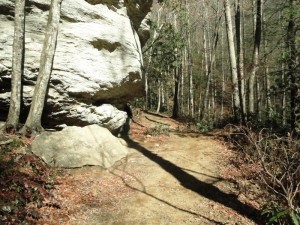Did You Know?
TDS has designed, constructed and maintained over 1000 miles of trail.
678-410-8021
 At Trail Design Specialists, we believe the only way to create a trail that excites users and gives them a positive experience is to participate in the activities for which the trail is being designed. In that respect, we enjoy hiking, mountain biking, horseback riding, and off-road motorcycling. We are not just weekend enthusiasts; our way of life revolves around our love of the outdoors.
At Trail Design Specialists, we believe the only way to create a trail that excites users and gives them a positive experience is to participate in the activities for which the trail is being designed. In that respect, we enjoy hiking, mountain biking, horseback riding, and off-road motorcycling. We are not just weekend enthusiasts; our way of life revolves around our love of the outdoors.
Our experience in working in different environments and with so many soil types has given us the insight to create unique trails that will endure the test of time, yet remain easy
and cost effective to maintain.
Do you have a problem or question no one seems to be able to answer?
Maybe you just want a second opinion. Whatever your need,
Trail Design Specialists can help! Contact Us.
Mike Riter has been involved with trails since his early years as a boy scout. Throughout his adult life Mike has been determined to give something back to the great outdoors, a place that has given him many hours of peace and recreation.
 Mike Riter, trails educator |
In 1992, Mike started working as a volunteer with various mountain bike organizations. By doing this, he learned more about the basics of maintaining and constructing shared use trails. It was at this point that he started to notice the effects erosion had on different types of trail design.
1996 brought the Olympic games to Atlanta, GA and the first ever Olympic Mountain Bike race. The event was held at the Georgia International Horse Park in Conyers, GA a suburb of Atlanta. Once the race was over, Mike approached the park in hopes of allowing continued use of the trails.
Permission was granted and he became the first Trail Coordinator at this historic site. With the help of the Southern Off Road Bicycle Association (SORBA), the battered course was rebuilt and what was once used as an Olympic mountain bike course was now open to the public. However, several design flaws became readily apparent so in an attempt to stem erosion, standard water deflection devices were installed.
While these methods worked for a short while, they required quite a bit of maintenance to ensure the continued desired effect on the trail. There had to be a better way.
1997 brought an invitation from the International Mountain Bike Association (IMBA) to start a trails education program to travel all over the US and help solve common trail problems such as erosion, user conflict and overuse. Hence, the IMBA/Subaru Trail Care Crew program was born. He embarked on a trail odyssey to change the way they and the world looked at trails. During the first year on the road, he realized different soil types had a direct affect on impacts and erosion. Listening carefully to knowledgeable locals, he soon started to gather the clues that would give him answers in the quest for, “a better way”.
 A fine example of a rolling grade dip. The water is directed off the trail down the slope. |
After the end of the first year, Mike started testing many of the different ideas he had learned during his travels. With time to devote to learning and improving current trail design and maintenance standards, he developed two important truths. First, most erosion and impact problems could be directly attributed to trail design not use. For example, when a rut develops in the middle of a trail running straight down a slope the problem is usually attributed to user impacts and erosion. In reality, poor design caused the problem and only through design will the problem be solved. Second, when maintaining trails, it is imperative you work with the natural surroundings rather than trying to control them. For example, a water bar placed on a steep trail diverts water off to the side causing an abrupt change in direction.
When this happens, the water starts to eat away at the water bar or the dirt holding it in place requiring the device to be frequently maintained. Because water bars are an unnatural trail feature, they are noticed and avoided by trail users of all types. This results in unintentional trails being created around one side or the other of this unnatural device rendering the water bar useless and requiring even more maintenance. A better way would be to incorporate grade dips that are more natural and ease water off the trail rather divert it. Users rarely notice a well-built dip and therefore do not affect it nearly as much. A better waywas developing.
In 1998, Mike started the first trail school devoted exclusively to the design construction and maintenance of natural surface trails and later the same year the crew was awarded the Advancements in Trail Technology award from the American Trails Association for new innovations that helped bring trail design into modern times. Three years on the road had taken him to every state in the continental United States, Canada, and several European countries where he worked on trails or taught others what they knew. In 1999, he decided it was time to retire and started a trail consulting business of his own while continuing research on the “better way”. Mike was also hired as Georgia’s Trails Education Specialist through a Recreational Trails Program grant that was written by the Southern Off Road Bicycle Association. This position has allowed him to continue educating (and learning from) others so they too can start to see “a better way”.